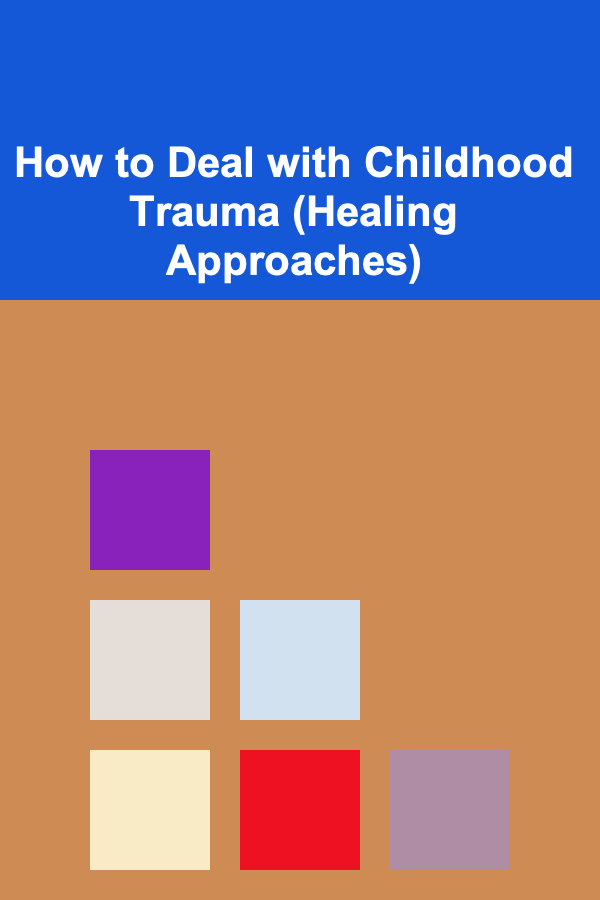
How to Deal with Childhood Trauma (Healing Approaches)
ebook include PDF & Audio bundle (Micro Guide)
$12.99$8.99
Limited Time Offer! Order within the next:

Childhood trauma is a deep and often hidden issue that affects millions of people worldwide. It can manifest in many ways, including emotional, physical, or sexual abuse, neglect, bullying, parental separation, and other distressing experiences that disrupt a child's sense of safety and trust. The impact of these traumatic events can be profound, affecting one's emotional health, relationships, and overall well-being well into adulthood.
Healing from childhood trauma is a complex journey that requires patience, self-compassion, and dedication. It involves understanding the effects of trauma, seeking appropriate treatment, and finding ways to foster emotional resilience. In this article, we will explore various approaches to healing from childhood trauma, offering insights into effective methods and strategies that can help individuals reclaim their lives and move towards a healthier, more fulfilling future.
Understanding Childhood Trauma
Childhood trauma occurs when a child experiences an event or series of events that overwhelms their ability to cope and creates significant emotional distress. These events may be one-time occurrences or ongoing situations that disrupt the child's sense of safety, security, and emotional stability.
Types of Childhood Trauma
- Emotional Abuse: This includes verbal attacks, manipulation, belittling, and shaming. Emotional abuse erodes a child's self-worth and can have long-lasting effects on their mental health.
- Physical Abuse: Physical abuse involves hitting, slapping, or otherwise inflicting harm on a child's body. It can result in physical injury and emotional scars.
- Sexual Abuse: This form of trauma occurs when a child is subjected to unwanted sexual advances or acts. It has profound emotional and psychological impacts, often leading to issues with intimacy, trust, and self-esteem.
- Neglect: Neglect involves the failure to provide a child with basic needs, including food, shelter, clothing, medical care, and emotional nurturing. Neglect can severely impair a child's development, leading to attachment issues and emotional problems.
- Witnessing Violence: Children who witness domestic violence, community violence, or other traumatic events may experience trauma even if they were not direct victims themselves.
- Parental Separation or Divorce: The breakdown of a family unit can be traumatic, particularly if it involves conflict, abandonment, or an unstable living environment.
- Bullying: Childhood bullying can cause emotional and psychological harm that lingers well into adulthood. The feeling of being ostracized or ridiculed by peers can affect a child's self-esteem and mental health.
The Long-Term Effects of Childhood Trauma
Traumatic experiences in childhood can create lasting impacts that extend into adulthood. These effects can manifest in various ways, such as:
- Emotional Issues: Anxiety, depression, anger, and shame are common emotional struggles faced by those with a history of childhood trauma.
- Attachment Problems: Children who experience trauma may have difficulty forming healthy, trusting relationships in adulthood.
- Post-Traumatic Stress Disorder (PTSD): Many trauma survivors experience flashbacks, nightmares, and heightened anxiety. PTSD can occur when a person is unable to process or cope with past traumatic events.
- Substance Abuse: Individuals with childhood trauma may turn to drugs or alcohol as a means of coping with pain or numbing their emotions.
- Self-Harm: As a way to deal with overwhelming emotions, some individuals may engage in self-harming behaviors.
- Dissociation: Trauma survivors may detach from reality or have difficulty grounding themselves in the present moment, often as a result of overwhelming emotional pain.
The impact of childhood trauma varies greatly from person to person, and some individuals may not fully recognize the effects until later in life. The healing process requires an understanding of how trauma has shaped one's emotional and psychological state and a willingness to address and work through the underlying issues.
Healing Approaches to Childhood Trauma
While healing from childhood trauma is a personal journey, there are several therapeutic approaches that have been shown to help individuals process their trauma and move forward. These approaches include both psychological and physical healing methods, designed to support the individual on their path to recovery.
1. Therapy and Counseling
One of the most effective ways to heal from childhood trauma is through therapy and counseling. A trained mental health professional can help individuals explore the root causes of their trauma, process difficult emotions, and learn healthy coping mechanisms. Several types of therapy are particularly helpful in treating childhood trauma:
- Cognitive Behavioral Therapy (CBT): CBT helps individuals identify negative thought patterns and replace them with healthier, more constructive beliefs. This type of therapy is often used to treat anxiety, depression, and PTSD.
- Trauma-Focused Cognitive Behavioral Therapy (TF-CBT): TF-CBT is specifically designed for individuals who have experienced trauma. It helps survivors understand how their trauma affects their thoughts and behaviors, while also teaching them coping skills to manage stress and anxiety.
- Eye Movement Desensitization and Reprocessing (EMDR): EMDR is a type of therapy that uses bilateral stimulation (such as eye movements or tapping) to help individuals process traumatic memories and reduce their emotional charge. It has been particularly effective in treating PTSD and trauma-related disorders.
- Psychodynamic Therapy: This type of therapy delves into unconscious thought patterns and how past experiences influence current behavior. It helps individuals uncover deep-seated emotions related to past trauma and work through them.
- Dialectical Behavioral Therapy (DBT): DBT is often used for individuals with emotional regulation issues. It teaches mindfulness, emotional tolerance, and distress tolerance skills, making it useful for individuals who struggle with intense emotions as a result of trauma.
2. Building Self-Compassion
For many survivors of childhood trauma, the negative beliefs instilled during their formative years continue to impact their self-worth. They may feel unworthy of love, happiness, or success, or may engage in self-blame for the trauma they experienced. Developing self-compassion is essential for healing, as it helps individuals treat themselves with kindness and understanding rather than criticism.
Practicing self-compassion involves:
- Self-Forgiveness: Understanding that the trauma was not your fault and that you deserve to heal.
- Mindfulness: Being present with your emotions without judgment or self-criticism.
- Gentleness: Treating yourself with the same kindness that you would offer a loved one.
By fostering self-compassion, individuals can begin to rebuild their self-esteem and self-worth, creating a foundation for lasting healing.
3. Mindfulness and Meditation
Mindfulness and meditation practices are powerful tools for managing the emotional and physical symptoms of trauma. These practices encourage individuals to focus on the present moment and develop a non-judgmental awareness of their thoughts, feelings, and bodily sensations. Mindfulness and meditation have been shown to reduce anxiety, depression, and PTSD symptoms.
By practicing mindfulness, individuals can learn to detach from the past and cultivate a sense of calm and control in their daily lives. Meditation, in particular, can be an excellent way to ground oneself when feeling overwhelmed by memories or flashbacks.
4. Somatic Experiencing
Somatic Experiencing (SE) is a therapeutic approach that focuses on the connection between the body and the mind. It emphasizes the idea that trauma is stored in the body and can manifest as physical tension, pain, or discomfort. SE helps individuals become aware of bodily sensations and learn to release stored trauma through physical movement and awareness.
This approach encourages individuals to "feel" their emotions in a safe and controlled manner, allowing them to process the trauma and release it from the body. Somatic experiencing can be particularly helpful for individuals who struggle with dissociation or physical symptoms related to trauma.
5. Expressive Arts Therapies
Expressive arts therapies, such as art therapy, music therapy, and dance/movement therapy, can be effective tools for trauma healing. These therapies encourage individuals to express emotions that may be difficult to verbalize, allowing for a creative release of pain and a deeper understanding of one's emotional state.
Art therapy, for example, allows individuals to create visual representations of their experiences, which can help externalize and process trauma. Music therapy uses the power of sound and rhythm to promote healing, while dance/movement therapy helps individuals reconnect with their bodies and release pent-up emotions.
6. Creating Safe Relationships
One of the most important aspects of healing from childhood trauma is learning to form safe, supportive relationships. Many trauma survivors have difficulty trusting others or may experience challenges in maintaining healthy, stable relationships. However, positive relationships with compassionate individuals can be incredibly healing.
Building safe relationships involves:
- Setting Boundaries: Learning to establish and maintain healthy emotional boundaries to protect yourself from further harm.
- Seeking Support: Surrounding yourself with individuals who are understanding, empathetic, and respectful of your healing process.
- Trusting Gradually: Allowing yourself to trust others over time and at your own pace.
Support groups, both in person and online, can also be an invaluable resource. Sharing your experiences with others who have faced similar challenges can provide a sense of community and lessen feelings of isolation.
7. Physical Healing and Exercise
Trauma affects not just the mind, but the body as well. Physical activity can play a crucial role in healing from childhood trauma by releasing endorphins, improving mood, and increasing overall well-being. Exercise has been shown to reduce anxiety, depression, and PTSD symptoms, making it an essential component of trauma recovery.
Engaging in activities such as yoga, tai chi, running, or even walking can help trauma survivors reconnect with their bodies and release pent-up stress and tension. Yoga, in particular, is beneficial because it combines movement, mindfulness, and breathing exercises, promoting both physical and emotional healing.
8. Developing a Sense of Purpose
Healing from childhood trauma often involves reconnecting with one's sense of purpose and identity. Many survivors of trauma may struggle with feelings of worthlessness or confusion about their place in the world. Engaging in meaningful activities, setting goals, and finding a sense of purpose can help individuals reclaim their lives and move forward.
This could involve pursuing a passion, volunteering, engaging in creative projects, or contributing to a cause that aligns with one's values. Having a sense of purpose fosters empowerment and gives individuals a reason to keep moving forward on their healing journey.
Conclusion
Dealing with childhood trauma is a deeply personal and transformative journey that requires time, patience, and support. Healing is possible, but it takes a commitment to understanding the impact of trauma, engaging in therapy, developing self-compassion, and finding healthy ways to cope with emotions. Whether through therapy, mindfulness, physical exercise, or creative expression, there are many healing approaches that can help individuals move beyond their traumatic past and build a future of hope, strength, and resilience.
By embracing the healing process and taking proactive steps, trauma survivors can reclaim their power and live fulfilling, meaningful lives.

How to Use Under-Bed Storage to Free Up Space in Your Bedroom
Read More
Top Tips for Saving on Baby and Child Supplies Without Sacrificing Quality
Read More
How to Use Gimbals for Smooth Shots
Read More
How to Collect Marine Biological Samples
Read More
Navigating the World of Free Wi-Fi Hotspots: Security, Best Practices, and Beyond
Read More
10 Tips for a Gluten-Free Recipe Planner Success
Read MoreOther Products

How to Use Under-Bed Storage to Free Up Space in Your Bedroom
Read More
Top Tips for Saving on Baby and Child Supplies Without Sacrificing Quality
Read More
How to Use Gimbals for Smooth Shots
Read More
How to Collect Marine Biological Samples
Read More
Navigating the World of Free Wi-Fi Hotspots: Security, Best Practices, and Beyond
Read More